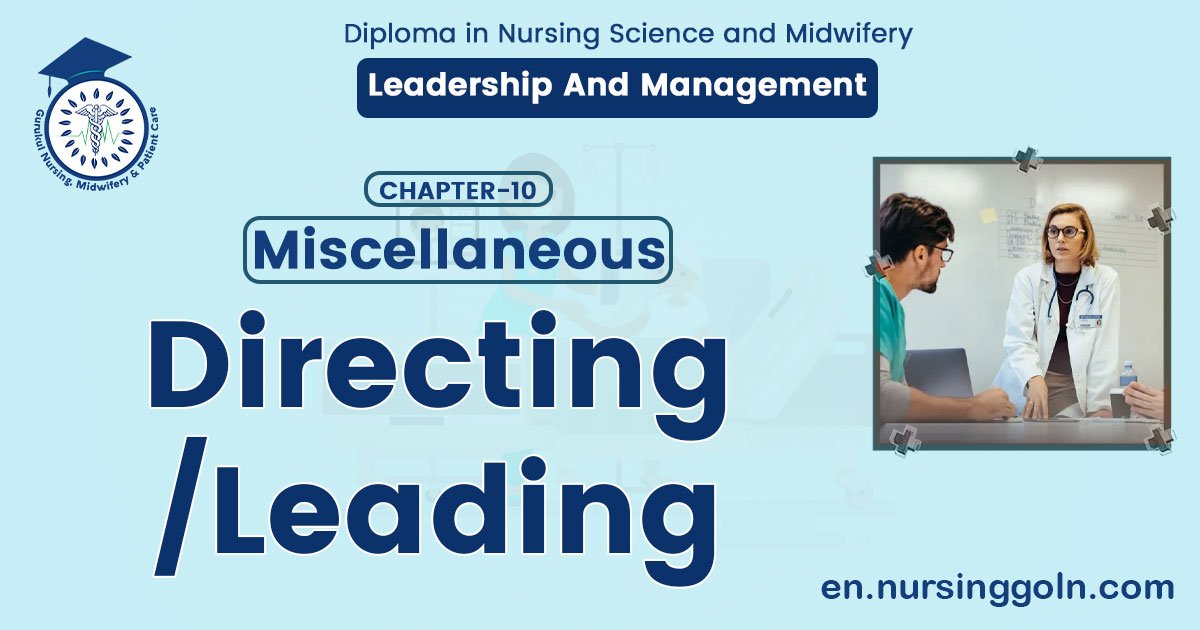Definition of Directing / Leading – This book covers the entire syllabus of “Leadership & Management” prescribed by the BNMC for Diploma in Nursing Science & Midwifery Students.
We tried to accommodate latest information and topics. This book is an examination setup according to the teachers’ lectures and examination questions. At the end of the book previous university questions are given. We hope in touch with the pook students’ knowledge will be upgraded and flourished. The unique way of presentation may make your reading of the book a pleasurable experience.

Definition of Directing / Leading
Direction is the administrative/managerial effort, which is applied for guiding and inspiring the working team to make better actions in the organization.
Or,
“Direction means giving the order to start the operation for implementations of a policy of plan”
(Ref by- BT Basavanthappa/Nursing Administration/24/212)
Definition of Directing:
“Directing is said to be a process in which the managers instruct, guide and oversee the performance of the workers to achieve predetermined goals”.
Or,
Directing is concerned with guiding, instructing, supervising and inspiring people in the organization to achieve its goals. It is telling people what to do and seeing that they do it. The directing function thus, consists of giving orders and instructions to the subordinates as also guiding and inspiring them. It involves:
- Telling people what is to be done and explaining how to do it.
- Issuing instructions and orders to subordinates.
- Inspiring them to contribute towards the accomplishment of objectives.
- Supervising their activities and
- Providing leadership.
Importance of Directing:
Directing is very important administrative function in every organization to implement a plan into action. Through direction, administrative initiates action in the organization, gets things done through instructions and provides subordinates opportunities for improvement.
The directing is important to achieve the organizations goals through following functions:
- It guides and instructs the subordinates to complete the given tasks.
- Through directing, the administrator/supervisor motivates to complete the work satisfactorily.
- It integrates employee’s efforts.
- It helps to unify the activities
- Directing is essential for ensuring that work is performed according to the orders and instructions.
- It facilitates changes in the organization.
- Directing is supportive to achieve organizational goals as well as individual goal through harmonizing the employee’s objectives with those of the organizations objectives.

Principles of Direction:
The important principles for effective direction are as follows:
1. Unity of command: An employee should receive command from one superior at a given time.
2. Principles of communication: A superior should use downward communication to pass orders, ideas about work to the subordinates and through upwards communication; he should know how they are working.
3. Principles of use of informal organization: In this regard, the administrator should realize, accept and use the informal organization to enhance and support the formal channels of communication.
4. Effective leadership: Dynamic leadership is very important for successful direction. A successful leader counsels and directs employees on work problems and on their personal problems.
Features of Direction:
The features of direction are:
1. It is continuous process
2. It is an essential administrative function
3. It is a persistent role and performed at all levels of administrative.
4. It stats at the top level in the organization and flows to bottom through chain of command.
Another Answer
Characteristics of Direction:
Direction has got following characteristics:
1. Pervasive Function – Directing is required at all levels of organization. Every manager provides guidance and inspiration to his subordinates
2. Continuous Activity – Direction is a continuous activity as it continuous throughout the life of organization.
3. Human Factor – Directing function is related to subordinates and therefore it is related to human factor. Since human factor is complex and behaviour is unpredictable, direction function becomes important.
4. Creative Activity Direction function helps in converting plans into performance Without this function, people become inactive and physical resources are meaningless.
5. Executive Function – Direction function is carried out by all managers and executives at all levels throughout the working of an enterprise, a subordinate receives instructions from his superior only.
6. Delegate Function – Direction is supposed to be a function dealing with human beings. Human behaviour is unpredictable by nature and conditioning the people’s behaviour towards the goals of the enterprise is what the executive does in this function. Therefore, it is termed as having delicacy in it to tackle human behaviour.

MC Gregors theory “X” and Theory “Y”:
McGregor’s Theory X and Theory Y are theories about human behavior and motivation in the organization that was published in 1960 by Douglas McGregor. This theory divides workers and managers in the organization in two typical groups according to how managers lead their subordinates and respectively how subordinates behave.
♦ Character of the manager or worker corresponding to the theory X:
- Employee does not like to work and avoids work
- Motivation of employees is based on coercive factors using external stimuli (punishment, reward)
- The work of employees must be controlled
- Employees avoid responsibility
- Employees will be better managed and guided to avoid having to take responsibility
- Employees have a reluctance to change
♦ Character of the manager or worker corresponding to the theory Y:
- Work is for the employee as natural an activity as fun or recreation
- Employee gladly accepts autonomy and responsibility, and even actively seeks it
- Employee fully agrees with the goals of the organization and is in accordance with them
- Employee has enough self-discipline and self-control to the objectives performance of the organization
- Employee demonstrates an actively creative and innovative approach to the challenges of the organization
Read more:
